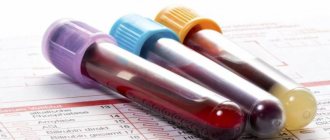In the modern world, according to medical statistics, more than 60.0% - 70.0% of the population after the age of forty have an increased cholesterol index in their blood, which provokes the growth of atherosclerotic plaques inside the arteries.
Cholesterol has the following structure:
- High-density lipoproteins - HDL (good cholesterol);
- Low-density lipoproteins - LDL (bad cholesterol);
- Very low density lipoproteins - VLDL.
Each type of cholesterol molecule is necessary for proper lipid metabolism, but when there are disturbances in fat metabolism and there is an excess of low molecular weight cholesterol in the body, then this threatens to disrupt the functionality of the heart organ, as well as malfunction of the blood flow system and the development of the pathology of atherosclerosis of the main arteries and peripheral vessels.
Alpha and beta cholesterol - what is it?
In a biochemical analysis of the lipid spectrum of the blood composition, total cholesterol is isolated, as well as the components of the cholesterol molecule - alpha lipoproteins, as well as beta lipoproteins.
Alpha lipoproteins are high molecular weight HDL cholesterol.
Beta lipoproteins are low molecular weight LDL cholesterol, as well as VLDL.
Cholesterol molecules are transporters of nutrients in the bloodstream; the higher the molecular weight of the lipoprotein, the better it copes with the work of transporting nutritional components through the main vessels of the bloodstream.
HDL, in addition to transporting nutrients to the tissues of the body, collects excess fat in the main arteries and delivers it to the liver cells, where they are utilized with the help of bile acid.
If the cholesterol molecule contains a sufficient amount of HDL, then it fully copes with the task of cleaning the blood vessels from excess lipids.
If the molecule is oversaturated with beta lipids, then it loses its transporter abilities and is deposited on the main arteries, causing the development of the pathology atherosclerosis.
The more beta lipoproteins in a cholesterol molecule, the more dangerous it becomes for the vascular system.
Beta lipoproteins cause pathological disorders in the heart organ, in liver cells, in the kidney organ, in the brain vessels, in various parts of the arteries of the bloodstream system.
Uncontrolled levels of good and bad cholesterol in the blood can lead to the development of serious pathologies in the body, which can cause death.
What is a laboratory test for alpha lipoprotein?
In order to correctly diagnose the pathology and establish a diagnosis for a competent course of treatment for pathologies of the vascular system and cardiac organ, with an increased total cholesterol and low molecular density lipoproteins, it is necessary to do a laboratory analysis of the concentration of lipoprotein A.
It is very important to find out when diagnosing what role alpha lipoprotein and the Apo A index, which has a genetic etiology, play in increasing LDL.
An appointment for testing is given by a cardiologist, and if the patient has diabetes mellitus, a consultation with an endocrinologist is necessary.
Quite often, when diagnosing pathologies of the blood flow and heart systems, consultation with specialized specialists is required - a phlebologist and an infectious disease specialist.
This analysis is prescribed to the following categories of patients:
- When collecting anamnesis, there is an early risk of developing pathologies of the vascular system and heart;
- Patients with a hereditary predisposition to cardiovascular diseases;
- For hypercholesterolemia that cannot be treated with medications;
- Patients with the development of diseases of the heart organ and blood flow system who do not have genetic risk factors;
- Patients who have been diagnosed with renal disease;
- Pathology: type 1 and type 2 diabetes mellitus;
- Before surgical intervention in the blood flow system using coronary artery bypass grafting;
- During angioplasty surgery;
- In childhood, when the disease develops, thromboembolism occurs.
Decoding the results
Functions in the body
Beta lipids, as well as alpha lipids, are the main transport carriers of cholesterol throughout the body, which saturates organ cells with nutritional components.
B-lipoproteins are actively involved in the transport of carotenoids through the bloodstream, as well as triglycerides and vitamin E.
There is a difference in the structure of high molecular weight and low molecular weight lipoproteins.
Low molecular weight B-lipids, dissolving in the blood plasma, precipitate, which settles in the form of a fatty spot on the inside of the vascular membranes.
If alpha lipids predominate in the blood, then they remove the sediment, and no changes occur in the bloodstream; with an increased level of LDL, the sediment forms a cholesterol plaque, which subsequently becomes the cause of the development of vascular pathology - atherosclerosis.
Physiological parameters of lipoprotein A molecules
Lipoprotein A takes an active part in the coagulation process of blood plasma composition, as a component of the LDL molecule, as well as in the metabolism of cholesterol and triglyceride molecules in the body.
For this reason, lipoprotein A is one of the participants in the formation of blood clots and provokes systemic pathologies and diseases of the heart organ.
Lipid A molecules are diagnosed in blood clots, which causes thrombosis of the great vessels.
With a high lipoprotein A index, the risk of developing coronary artery thrombosis increases by 70.0%.
There are also other indicators of the influence of this lipid on thrombus formation in plasma blood:
- The atherogenic abilities of lipid A enhance the transport effect of oxidized phospholipids along the bloodstream;
- LP A index higher than 26.0 milligrams per deciliter provokes the formation of clots in the blood plasma;
- Alpha cholesterol is an inhibitor of plasmogens that dissolve fibrin molecules and help thin blood clots;
- Lipoprotein A has the ability to penetrate the cerebrospinal fluid and have a negative effect on all centers of the human nervous system.
As the human body begins to age, the risks of cardiac complications due to high Lp A levels decrease, so after 65 years this indicator is no longer thoroughly studied.
In the pathology of diabetes mellitus, the analysis results often indicate a high LP A coefficient. But the connection between a high glucose index during hyperglycemia and lipoprotein A has not been identified.
In type 1 diabetes (insulin-dependent), it is possible to increase LA A above 36.0 milligrams per deciliter, which can provoke a glycemic coma and lead to death in the patient.
In a child’s body, an Lp A value greater than 30.0 milligrams per deciliter can provoke the disease venous thromboembolism.
Alpha cholesterol is predominantly diagnosed in elevated form in children with large body weight - in obesity.
Physiological characteristics
Biochemical lipid analysis of blood composition
In order to find out the level of lipoprotein in the blood plasma, it is necessary to test the blood using a laboratory biochemical lipid analysis method. L
The ipogram shows the level of total cholesterol in the blood, as well as its division into fractions of lipoproteins - HDL, and low molecular weight beta lipids LDL and VLDL prebeta.
A lipogram is performed when the patient’s total cholesterol level is elevated, or the lipoprotein is in a borderline state.
Lipogram
Preparing for analysis
In order to take a biochemical lipid test, you need to prepare your body. Very often, doctors do not recommend that their patients undergoing a screening test carry out special preparation before taking blood in order to identify the indicators with which the patient lives every day.
But for most people the following preparation is recommended:
- Do not eat for 7 - 8 hours before donating blood for analysis, and do not abstain from food for more than 12 hours to avoid exhaustion of the body;
- Two days before donating blood, do not drink any alcoholic beverages;
- 3 hours before the procedure - do not smoke;
- Do not drink more than 150 - 200 milliliters of purified water;
- If the patient is taking medications, the doctor must be told about this;
- 7 - 10 days before the blood sampling procedure for biochemistry, stop taking antibiotics, vitamins and dietary supplements, as well as hormone-based drugs. Also, taking diuretics can affect the lipogram;
- Do not overload the body on the eve of donating blood;
- If the work was very hard, then you need at least 7 days to restore the body, and then do a lipogram;
- Do not get overexcited and take the test in a calm state;
- In the case of an infectious or viral disease, it is necessary to wait 45-50 days after recovery, and then only take a blood test;
- The same conditions for conducting biochemistry in the postpartum period;
- Women during menstruation should not refuse to undergo biochemistry, because the cholesterol index is not distorted during this period.
Biochemical lipid analysis
What is lipoprotein A?
In addition to alipoprotein A, the lipoprotein A molecule includes:
- Glycoprotein molecules (Apo A);
- cholesterol;
- triglycerol molecules;
- phospholipids;
- Molecules A to B.
The concentration of lipoprotein A in the blood plasma depends on Apo A - the lower the concentration of Apo A molecules, the higher the concentration of lipid A. This depends on the functionality of the genes that encode the production of apo A.
Concentrations in plasma blood can vary between 0.10 milligrams per deciliter and 200.0 milligrams per deciliter of blood. The average normative index for the concentration of lipoprotein A in plasma blood is up to 14.0 milligrams per deciliter.
Also, the lipoprotein A molecule contains low molecular weight cholesterol, which contains apolyprotein B. This, of course, does not significantly affect its index in the blood.
Only 10.0% may be the cause of this pathology, but 90.0% of the LA A level is determined genetically.
There is also a pattern of growth in the LP A indicator - it grows rapidly in a child after birth and reaches maximum numbers after adulthood.
After this, the fluctuation in the indicator stops and LP A remains within the same values. An increase in the body occurs in women during menopause and at the onset of menopause.
The risks of developing cardiac and vascular pathologies from an increased LP A index do not depend on age category or gender, and there is no increase from poor nutrition, smoking and alcoholism.
But there are still prerequisites for an increase in lipoprotein A.
Lipoprotein A
Decoding biochemistry for cholesterol
The level of cholesterol in the blood is divided according to the following indicators:
- The cholesterol index in women and the indicator in the male body are different;
- The indicators are affected by the patient’s age - cholesterol is higher in older men and the fairer sex;
- Women are 4 times less likely to suffer from increased cholesterol in the blood, only during menopause the chances of accumulation of atherosclerotic lipid plaques are comparable.
The normal levels of lipoproteins in the female body range from 1.90 mmol per 1 liter of blood to 4.60 mmol per liter.
According to medical experts, the presence of up to 5.0 mmol per liter of cholesterol in the blood is an acceptable level, at which there is no threat of lipid accumulation on the membranes of the main arteries of the vascular system.
According to international indicators, the norm of total cholesterol in the blood is up to 60.0 mmol/l, and does not pose a danger to the heart organ, as well as to the bloodstream system.
Norm for men by age
If the indicator is about 50.0 units. mmol/l, both in men and women, it is necessary to begin treatment, because there is a threat of the appearance of prebetalipoproteins in the molecules.
Women, just like men, need to systematically donate blood for biochemical analysis of cholesterol and do a lipid profile as part of preventive measures.
Norm for women by age
What are normal levels of alpha cholesterol?
There are only index level recommendations
High-density lipoprotein concentrations are determined depending on the age and gender of the patient. There is no exact number indicating the norm of its content. There are only index level recommendations. Indicators that differ from it, up or down, indicate some kind of disease.
Normal human lipoprotein levels at different periods of life:
| Age, g | mmol, l |
| 0 — 5 | 0,98 — 1,94 |
| 5 — 10 | 0,93 — 1,94 |
| 10 — 15 | 0,96 — 1,91 |
| 15 — 20 | 0,91 — 1,61 |
| 20 — 29 | 0,78 — 2,04 |
| 30 — 39 | 0,72 — 1,99 |
| 40 — 49 | 0,7 — 2,28 |
| 50 — 60 | 0,79 — 2,38 |
| 60 and older | 0,68 — 2,48 |
The study is a labor-intensive process and is carried out using photometry and sedimentation methods. These methods are distinguished by accuracy and sensitivity.
Norms for lipogram
In order to determine the presence of cholesterol in the body and identify lipoproteins by fraction, you need to make a lipogram.
In accordance with the standard lipogram indicators:
- The normal B index of lipoproteins of the LDL fraction and the VLDL fraction (together) is 2.60 mmol per 1 liter of blood. If the lipid B index is elevated, then there is a great danger of disruption of the functioning of the blood supply system to all organs in the human body, and disturbances in the structure and performance of the heart organ;
- The standard high-density lipoprotein index in the female body should be no higher than 1.290 mmol per 1 liter of biological fluid; for the male body these units are slightly higher - the HDL norm is 1.360 mmol/l.
It is also necessary to take into account the ratio between high molecular weight lipoproteins and low density lipids.
If the lipogram results show that low molecular weight cholesterol is almost 3 times higher than high density lipoproteins, then in this case it is necessary to consult a doctor and begin therapy to reduce low molecular weight cholesterol.
According to the standard, the difference between HDL and beta lipids should be no more than 2 times.
Prevention: diet and lifestyle
Lifestyle changes are necessary to stabilize cholesterol levels. To normalize your lipid panel, you need to follow some recommendations.
Lifestyle changes:
- Losing weight. Losing even 2-5 kilograms will help lower your cholesterol levels.
- Eating a heart-healthy diet. Focus on plant-based foods, including fruits, vegetables and whole grains. Limit the amount of saturated fat found in red meat and dairy products and trans fat found in many processed foods. Monounsaturated fats, found in olive and canola oils, are a healthier option. Avocados, nuts and fatty fish are other sources of healthy fat.
- Regular exercise. Do at least 30 minutes of moderate-intensity exercise five times a week or vigorous exercise five times a week.
- To give up smoking. Find a way to quit smoking.
A few dietary changes will be enough to lower your cholesterol to healthy levels and help you avoid taking medications.
Add cholesterol-lowering foods to your diet:
- Oatmeal and oat bran.
- Walnuts, almonds and other nuts.
- Fish, especially mackerel, lake trout, herring, sardines, tuna and salmon.
- Foods fortified with plant sterols or stanols, such as orange juice and yogurt drinks.
Reasons for increased beta lipoproteins
With age, everyone's total cholesterol increases, but it may not always cause concern. An increase in beta lipoproteins poses a threat to human health.
This must be taken into account for those patients who have the following risk factors:
- Pathology cholestasis - stagnation of bile due to improper functioning of liver cells, which is provoked by hepatitis, as well as cirrhosis of the liver organ;
- Pathology cholecystitis - disorders with the removal of bile from the ducts;
- Oncological neoplasms in liver cells and gall bladder;
- Diseases of the kidney organ, which led to failure of this organ;
- Nephrotic syndrome;
- Disease of the endocrine system - hypothyroidism (disturbance in the functioning of the endocrine organ of the thyroid gland);
- Pathology of the endocrine organ of the pancreas, causing the disease diabetes mellitus;
- Overweight - obesity;
- Physical inactivity;
- Disturbances in metabolic processes in the body;
- Age-related changes in hormonal levels and the production of sex hormones;
- Prostate adenoma (in men);
- Menopausal syndrome in women;
- Hereditary genetic predisposition;
- Non-compliance with dietary culture - eating large amounts of fatty foods;
- Nicotine addiction;
- Chronic alcoholism.
Obesity is one of the factors influencing the increase in beta lipoproteins in the blood
Increases in alpha cholesterol levels
The content of HDL in the body can change for various reasons. The process is not determined by noticeable symptoms; deviations can only be detected by blood tests.
The index increases with the following diseases:
- alcohol poisoning;
- fatty liver hepatosis;
- obesity;
- stopping the removal of cholesterol in the required amount due to genetic mutations;
- biliary cirrhosis of the liver;
- hyperalphapipoproteinemia - a hereditary disease is discovered, usually by chance, when the consequences become obvious.
Important! In pregnant women, starting from week 34, an increase in HDL alpha cholesterol is not considered a pathology. The compound is the main material in the structure of the placenta and the formation of the fetus.
Reasons why beta lipoproteins decrease
Beta lipoproteins decrease much less often than they increase.
Reduced beta lipids may occur in the following cases:
- Hereditary genetic predisposition;
- Diseases of the liver organ;
- Oncological neoplasms in bone marrow cells;
- Disruption of the endocrine system;
- Hyperthyroidism of the endocrine organ of the thyroid gland;
- Excess in the production of hormones by endocrine organs;
- Autoimmune pathologies that cause arthritis;
- Arthrosis of bone tissue;
- Burns that occupy more than half of the skin and muscle tissue of the human body;
- Invasion of the body by infection in the acute stage of disease development;
- Asthma of bronchial type.
Blood beta lipoproteins (LDL) - what is it and what is the norm in men and women.
High cholesterol is a common disease these days. Most people believe that cholesterol only causes harm to the body.
In fact, not everything is so simple. Cholesterol is vital for the normal functioning of the entire human body. But not all cholesterol is beneficial.
Thus, alpha (a) lipoproteins are called good cholesterol, and beta (b) lipoproteins are called bad cholesterol. The fact is that cholesterol on its own is not able to dissolve in the blood plasma - it is helped by a transport protein, which, when combined with cholesterol, forms lipoproteins.
Both good and bad cholesterol are vital for the body. But only on condition that both indicators do not exceed the norm. Otherwise, cholesterol will be harmful.
Lipid metabolism in men and women proceeds slightly differently. In their youth, representatives of the fair half of humanity are less at risk of developing atherosclerosis: the sex hormones estrogens act as “guardians” of women’s blood vessels from fat deposits. In old age, after menopause, the amount of hormones decreases sharply, and the prevalence of cardiovascular and neurological complications of atherosclerosis becomes approximately the same.
The norms of beta lipoproteins differ not only from gender, but also from the age of the subject. Their content in the blood consists of the concentration of very low-density drugs and low-density drugs.
Low-density lipoproteins are small spherical complexes of fat and protein cells. They contain up to 50% cholesterol and are its main carriers into the cells of the body. LDL is highly atherogenic and, when its concentration in the blood increases, quickly leads to the formation of cholesterol plaques. Reference values for low-density lipoprotein levels are presented in the table below.
Based on the data presented in the table, it can be seen that LDL levels in young women are slightly lower than in men of the same age. After age 50 (that is, after the average age of menopause in women), this ratio becomes reversed.
There are also general criteria for assessing the level of low-density lipoproteins in the blood for representatives of both sexes:
- less than 2.61 mmol/l – optimal;
- within 2.62 mmol/l – 3.30 mmol/l – close to optimal;
- 3.41-4.10 mmol/l – borderline high;
- 4.21-4.90 mmol/l – high;
- more than 4.91 mmol/l – critically high.
The norm for very low density lipoproteins is the same for men and women and is 0.26-1.04 mmol/l. This fraction of lipoproteins has ambiguous characteristics in the scientific world. Of course, most scientists agree that VLDL, along with LDL, are one of the main factors of atherogenicity. But while LDL performs many biological functions in the body, the role of very low-density lipoproteins has not been fully elucidated.
Due to the uncertainty of their “status”, international standards for assessing the safety of their quantities have not yet been developed. A decrease in low-density lipoprotein below 0.26 mmol/l is rare and does not have negative consequences for the body.
For beta lipoproteins, the norm changes with age and depends on gender. Adult men have higher levels of LDL cholesterol than women. With age, the concentration of beta lipoproteins (LDL) increases.
Age, years LDL level, mmol/l
| 5-10 | m | 1.64-3.35 |
| and | 1.77-3.64 | |
| 10-15 | m | 1.67-3.45 |
| and | 1.77-3.53 | |
| 15-20 | m | 1.62-3.38 |
| and | 1.54-3.56 | |
| 20-25 | m | 1.72-3.82 |
| and | 1.49-4.13 | |
| 25-30 | m | 1.82-4.28 |
| and | 1.85-4.26 | |
| 30-35 | m | 2.03-4.78 |
| and | 1.82-4.05 | |
| 35-40 | m | 2.11-4.91 |
| and | 1.95-4.46 | |
| 40-45 | m | 2.26-4.83 |
| and | 1.93-4.52 | |
| 45-50 | m | 2.52-5.24 |
| and | 2.06-4.83 | |
| 50-55 | m | 2.32-5.11 |
| and | 2.29-5.22 | |
| 55-60 | m | 2.29-5.27 |
| and | 2.32-5.45 | |
| 60-65 | m | 2.16-5.45 |
| and | 2.58-5.81 | |
| 65-70 | m | 2.55-5.45 |
| and | 2.39-5.73 |
The level of cholesterol and LDL depends on the physiological state of the body. This applies to women, since they experience cyclical fluctuations in the concentration of hormones that affect lipoprotein levels. Throughout the menstrual cycle, LDL cholesterol levels rise and fall.
Beta lipoproteins are elevated during pregnancy. The concentration of LDL is especially strong, and cholesterol levels increase by the third trimester. This is an absolutely normal phenomenon, which is explained by hormonal changes in the body.
Safe daily intake of cholesterol
Metabolic processes in female and male bodies proceed differently. That is why in medicine there are pathologies that are considered “male” or “female”. Young women are very rarely diagnosed with atherosclerosis. This is due to the active production of the hormone estrogen - it reliably protects a woman’s blood vessels from accumulations of harmful cholesterol. The male hormone is not able to protect blood vessels, so you need to get tested more often, reducing cholesterol levels if they are elevated.
Indicators will vary not only depending on the gender, but also the age of the patient. The content of very low-density and low-density lipoproteins is assessed. The first is a mixture of fats and proteins, shaped like a sphere. They contain predominantly cholesterol and are the main provocateurs of atherosclerosis.
- Age up to 19 years - for men from 1.54 to 3.60 mmol/liter, for women from 1.54 to 3.87 mmol/liter.
- From 20 to 30 years - for men from 1.52 to 4.49 mmol/liter and for women from 1.54 to 4.12 mmol/liter.
- From 31 to 40 years - for men from 2.09 to 4.91 mmol/liter and for women from 1.84 to 4.35 mmol/liter.
- From 41 to 50 years - for men from 2.30 to 5.32 mmol/liter, for women from 2.04 to 4.90 mmol/liter.
- From 51 to 60 years - for men from 2.31 to 5.30 mmol/liter and for women from 2.30 to 5.64 mmol/liter.
- From 61 to 70 years - for men from 2.31 to 5.56 mmol/liter and for women from 2.44 to 5.54 mmol/liter.
It can be noted that the concentration of this substance in young women is slightly lower than in men of the same age. But after fifty years the situation changes - now on the contrary, in women the level of lipoproteins becomes higher. The level of low-density lipoprotein is considered optimal if it does not exceed 2.61 mmol/liter.
Established standards for very low-density lipoprotein levels are the same for both males and females. Indicators range from 0.1 to 1.4 mmol/liter. At the same time, in medicine it has still not been established exactly what function this fraction performs in the human body. If low-density lipoproteins directly affect the formation of cholesterol plaques and the development of atherosclerosis, then very low-density lipoproteins do not have this property.
There is an opinion that these compounds initially belong to harmful breakdown products after fat metabolism and the body does not need them. A number of studies confirm this assumption. That is why there are no clearly established standards for the content of very low density lipoproteins in human blood. Their decrease or increase usually does not affect the overall clinical picture of the disease or the patient’s well-being.
Treatment of high beta lipoprotein index
Treatment for high cholesterol is prescribed by the doctor according to an individual regimen for each patient.
Prescriptions depend on the level of increase in beta lipoproteins, as well as on the degree of development of vascular pathology - atherosclerosis, and on the individual characteristics of the patient.
If beta lipoproteins are very elevated and atherosclerotic plaques have formed on the vascular membranes, then the use of medications cannot be avoided.
Non-drug therapy and prevention
If beta cholesterol is within the limit, you can do without drug therapy.
Food culture
This is a diet that consists of taking low-cholesterol foods. It is necessary to avoid eating red meat, as well as dairy products with a high fat content.
It is necessary to eat sea fish, which is rich in omega 3, and also consume vegetable fats. Introduce the maximum amount of fresh natural vegetables and garden herbs into your diet. Fruits can be used to replace fatty and sweet desserts.
You need to eat food in small portions, 5-6 times a day. It is also necessary to take into account the method of preparing foods so that they are less dangerous to the body.
If you have a high beta lipoprotein index, it is prohibited to cook foods by frying them in oil, bake them, steam vegetables, or stew them.
Active lifestyle
Exercise your body every day through active sports, you also need to move a lot and walk at least 10 kilometers;
Drink the required amount of clean water, because dehydration leads to thickening of the blood, which provokes the formation of clots. You need to drink up to 2 liters of water per day.
Alcoholic drinks
They prevent beta cholesterol from leaving the body. By getting rid of alcoholism, you can stop the progression of atherosclerosis.
Smoking
Nicotine addiction provokes constant spasms of the vascular membranes, which leads to the destruction of the membrane of the membrane and the retention of beta lipid sediment.
Quitting smoking will prevent the vascular membranes from narrowing and blood flow will restore its speed.
The faster the blood moves through the system, the more beta lipids leave the blood and are utilized by bile.
Non-drug treatment can also serve as measures to prevent atherosclerosis.
Preventive measures also include:
- Constant fight against obesity;
- Constant monitoring and adjustment of the blood pressure index;
- Monitoring blood glucose index;
- Systematic testing of beta lipoproteins using biochemistry.
How to donate blood for beta lipoproteins correctly
Traditionally, most laboratories require patients to fast for 9–12 hours before screening. Tests are taken on an empty stomach, which means that you must refrain from eating before taking the test. There are no restrictions on drinking plain water. Certain situations and factors may affect test results.
You should not undergo lipoprotein testing if you have any of the following conditions:
- fever;
- infection;
- recent and significant weight loss;
- pregnancy.
The healthcare professional will take a blood sample from a vein in your arm using a small needle. After the needle is inserted, a small amount of biomaterial will be collected in a test tube or vial. You may feel a slight burning sensation as the needle enters or exits. The procedure usually takes less than five minutes.
Warning! There is little risk to the blood test. You may experience some pain or bruising where the needle was inserted, but most symptoms go away quickly.
Life forecast
With a slight increase in beta lipids, it is necessary to strictly adhere to proper nutrition and constantly combat the risk factors for increased cholesterol. If you constantly monitor the lipoprotein index, then the prognosis is favorable.
If there is a predisposition to the accumulation of bad cholesterol in the vessels, then maintenance therapy and diet are lifelong.
If the rules of treatment and prevention are not followed, the development of atherosclerosis is inevitable.
When is cholesterol testing necessary?
For healthy adults without cardiovascular risk factors, screening is recommended once every five years. A lipid profile may also be ordered at regular intervals to assess the success of lipid-lowering medications such as statins. Lipid testing is not performed in childhood and adolescence. However, it is recommended that children aged 9 to 11 years be screened once for serious cholesterol disorders.
Conditions for which cholesterol testing is indicated:
- High blood pressure.
- Diabetes mellitus type 2.
- Smoking.
- Overweight or obese.
- Lack of physical activity.
- Diet high in saturated fat.
Age may also be a factor because the risk of heart disease increases as you get older. Your doctor may order a cholesterol test as part of a routine checkup, or if there is a family history of heart disease.
On a note! This screening can be useful in identifying genetic diseases such as familial hypercholesterolemia, which can be fatal if not treated early.
Treatment of abnormalities
To normalize lipoprotein levels of different densities, drug therapy is usually used. However, if the blood test results slightly exceed the permissible norm, you can do without it. In any case, an important part of treatment is diet therapy.
Considering that cholesterol enters the body with food, it is necessary to limit the consumption of foods that are fatty. Fats of animal origin are replaced by vegetable ones. And also the daily diet should contain fresh vegetables, fruits, herbs, and other foods rich in fiber.
In addition to following a diet to balance lipoprotein levels in the blood, the patient receives doctor’s recommendations regarding a healthy lifestyle. Playing sports plays an important role. Your doctor can help you choose a sport that is appropriate for your age and general health. With elevated LDL levels, it is important to get rid of extra pounds, so physical activity should be regular.
If drug therapy is required, it usually includes drugs from the following groups:
- statins are the basis of treatment; drugs in this group reduce the production of LDL by the liver, fight existing cholesterol deposits, and have an anti-inflammatory effect;
- sequestrants – accelerate the removal of beta lipoproteins from the body;
- fibrates – increase the concentration and functionality of HDL;
- vitamins of different groups, especially group B, which have general strengthening properties.
Statins are a universal group of drugs for most conditions associated with abnormalities of lipoproteins of different densities
There is no general treatment regimen; the attending physician prescribes therapy. The basis for determining the treatment regimen is how high the lipoprotein levels are, how long ago they arose, and what complications have already developed.
In diabetes mellitus, it is important to control not only glucose levels, but also the concentration of lipoproteins in the blood. You can determine the atherogenicity coefficient, identify the amount of lipoproteins and their ratio by fraction, and also find out the level of triglycerides and cholesterol using a lipid profile.
Diagnostics
A lipoprotein test is performed by drawing blood from a vein. Before the procedure, the patient should not eat for twelve hours. One day before the test, you should not drink alcohol, and it is not recommended to smoke an hour before the test. After collecting the material, it is examined using the enzymatic method, in which the samples are stained with special reagents.
Normal lipoprotein levels differ between men and women. This is due to the fact that the atherogenicity coefficient in women is reduced due to the increased elasticity of blood vessels, which is provided by estrogen, the female sex hormone. After the age of fifty, lipoprotein levels become the same in both men and women.
HDL (mmol/l):
- 0.78 - 1.81 - for men;
- 0.78 - 2.20 - for women.
LDL (mmol/l):
- 1.9 - 4.5 - for men;
- 2.2 - 4.8 - for women.
Total cholesterol (mmol/l):
- 2.5 - 5.2 - for men;
- 3.6 - 6.0 - for women.
Triglycerides, unlike lipoproteins, have increased normal levels in men:
- 0.62 - 2.9 - for men;
- 0.4 - 2.7 - for women.
The atherogenic coefficient (AC) is calculated using the formula: (Cholesterol - HDL)/HDL. For example, (4.8 - 1.5)/1.5 = 2.2 mmol/l. - this coefficient is low, that is, the likelihood of developing vascular diseases is low. If the value exceeds 3 units, we can talk about the patient having atherosclerosis, and if the coefficient is equal to or exceeds 5 units, then the person may have pathologies of the heart, brain or kidneys.
Treatment is prescribed by a doctor in accordance with the individual characteristics of the patient. When the level of beta lipoproteins is at the limit of acceptable values and slightly exceeds them, medications are usually not prescribed. Instead, it is recommended to follow these guidelines:
- Proper nutrition means an almost complete abstinence from foods containing large amounts of animal fats. These include fatty meat, cheese, chips, fried potatoes, pizza, sausage, various confectionery products, ice cream, etc.
It is recommended to include dietary meat in the diet (horse meat, rabbit, turkey), fish dishes, a large amount of fresh fruits and vegetables, and legumes. It is also recommended to eat barley and oats (cooked), almonds, and peanuts, as these products help lower cholesterol levels.
Daily physical activity.
- Doctors recommend walking at least 10 kilometers every day. It is advisable to do this not on a treadmill, but in the fresh air.
Drinking large quantities of water.
- Drink at least a liter of water daily, gradually increasing to two liters per day.
Give up bad habits.
- Alcohol and nicotine interfere with the processing and use of cholesterol, which is why its level does not decrease, but only increases.
In addition (only after prior agreement with your doctor), you can try using alternative medical directions. For example, folk or homeopathic remedies.
If your cholesterol is significantly elevated, then follow all your doctor's instructions. Most likely, you will be prescribed drugs containing a statin, which blocks the production of lipoproteins by the liver. Alternative medicine for cholesterol levels significantly higher than normal can only be used as additional therapy and after permission from a doctor
Diagnostics
Lipogram and biochemical blood test
To find out how much cholesterol is in your body, you need to donate blood for a biochemical analysis. It will show the total amount of cholesterol in your blood without taking into account fractions (HDL, LDL, VLDL). Due to the fact that biochemistry shows only the total amount of cholesterol in the blood, in addition to these tests, it is necessary to do special tests - a lipogram, which is able to recognize the different fractions of cholesterol found in human blood.
A lipogram is done only when necessary. For example, if a person’s total cholesterol is elevated or close to elevated.
How to correctly decipher test results
Standards for cholesterol tests vary. This is explained by the fact that cholesterol levels differ between men and women. The age of the person also influences the indicators. The older the person, the higher the norm.
For a woman, the normal level is considered to be 1.9 - 4.6 micromoles per liter of blood. In men it is 2.2 – 5 micromoles per liter. However, we can say that these figures are approximate. Thus, most doctors believe that a level of 5 micromoles per liter in both men and women does not pose any danger. And according to generally accepted international standards, a figure of 6 micromoles per liter is considered normal.
An interesting fact from the history of cholesterol is that over the past 20 years, the normal level of this compound in the blood has changed several times. In the 1990s, a normal cholesterol level was considered to be up to 5 micromoles. Approximately every five years, this figure was gradually increased by 0.1-0.2 micromoles per liter.
But why is the figure constantly increasing? Of course, this is only an assumption, but people in the modern world practically do not monitor their diet and eat a huge amount of foods containing b lipoproteins every day. So, instead of treating people, it was much more convenient to gradually increase the normal level of cholesterol in the blood.
To begin with, most likely, you will be advised to take a lipogram test. It will help you find out the real cholesterol content of different fractions in your blood.
- The normal level of LDL and VLDL (together) is 2.6 micromoles per liter of blood. That is, the norm in lipoproteins is similar. Elevated levels of low and very low density lipoproteins pose a great danger to the body. If this indicator is elevated, then you can say with almost complete certainty that you will have problems with the cardiovascular system.
- HDL levels for women should normally not exceed 1.29 micromoles per liter of blood. For men, the norm for HDL is 1.036 micromoles per liter.
In addition, it is necessary to take into account the ratio of indicators. If your low-density lipoprotein and very low-density lipoprotein levels are three times higher than your high-density lipoprotein levels, be sure to consult your doctor.
It is believed that the difference between the indicators should be no more than twice.
What factors should be taken into account when deciphering the analysis?
As stated earlier, the results of the study should be reviewed by a doctor individually. If a person has recently suffered a heart attack or stroke, then the level of beta lipoproteins in his blood should be slightly lower.
Also, the indicators should be lower when:
- Constantly increased pressure in the arteries;
- Having bad habits (smoking, alcoholism, etc.);
- Atherosclerosis;
- Diabetes mellitus;
- Impaired blood supply to the brain, etc.
Indicators in patients with these ailments should be at a minimum level. Even a slight deviation from the norm can lead to unpredictable consequences.
Decreased beta lipoproteins in blood tests
A decrease in atherogenic lipoproteins is observed much less frequently. A decrease in their concentration is not a diagnostic sign due to low specificity. The following conditions can lower LDL levels:
- hereditary predisposition;
- severe liver diseases in the stage of decompensation;
- malignant bone marrow lesions;
- hyperthyroidism – excessive production of hormones by the thyroid gland;
- arthritis, arthrosis, including autoimmune;
- extensive burns over 50% of the body surface;
- acute infectious diseases;
- COPD, bronchial asthma.
If a decrease in the concentration of beta lipoproteins occurs for one of the above reasons, treatment should be aimed at the underlying disease. There is no need to specifically increase the level of atherogenic lipoproteins.
How to control lipoprotein levels
An increase in beta lipoproteins is not accompanied by symptoms until the atherosclerotic plaque formed by them blocks a significant part of the vessel. Therefore, all adults are recommended to check their cholesterol, LDL, LDL, and triglyceride levels every 4-6 years.
Patients with diabetes, patients with high blood pressure, a hereditary predisposition to the development of coronary heart disease, and smokers are at increased risk. They need to monitor the level of cholesterol fractions much more often.
Beta lipoproteins in the blood are determined using laboratory diagnostics. To do this, it is necessary to draw blood from a vein. LDL analysis is rarely performed separately from other lipid fractions. Usually, cholesterol, LDL, LDL, and triglyceride levels are checked at the same time. Such a comprehensive study is called a lipid profile.
Preparing for blood collection
A blood test for beta lipoproteins does not require complex preparation. It is necessary to follow the rules common to all biochemical studies:
- Before taking blood, do not eat for 12-14 hours. The only drinks allowed are water;
- the study of beta lipoprotein levels is carried out strictly in the morning: from 8 to 10 o’clock;
- the day before taking a lipid profile, refrain from alcohol and fatty foods;
- an hour before blood sampling, do not smoke, avoid emotional and physical stress;
- sit for 5 minutes immediately before the test.
Reasons for elevated levels
Elevated beta lipoproteins can be a symptom of a disease or the result of an unhealthy lifestyle. The main causes of abnormally high LDL levels are:
- pregnancy (considered normal);
- hyperlipoproteinemia types 1A, 2B;
- a diet containing excess cholesterol, saturated fats;
- kidney disease (chronic renal failure, nephrotic syndrome);
- blockage of the bile ducts;
- thyroid insufficiency;
- anorexia nervosa;
- obesity;
- diabetes;
- Cushing's syndrome.
Elevated LDL levels develop while taking diuretics, beta blockers, oral contraceptives, androgens, progestins, and glucocorticoids.
Beta lipoprotein analysis is used to determine the risk of cardiovascular complications of atherosclerosis: myocardial infarction, stroke, ischemia. High LDL helps detect fat metabolism disorders when it takes years for the first symptoms to appear.
Gradation of risks depending on the concentration of LDL.
| Concentration | Risk level | |
| mg/dl | mmol/l | |
| less than 50 | less than 1.3 | Optimal level, low risk of coronary heart disease |
| 51-69 | 1,3-1,79 | The optimal level of LDL, at which the rate of progression of atherosclerosis is minimal. This level is recommended to be achieved by people who have a clinical picture of the development of diseases. |
| 70-99 | 1,8-2,59 | Low LDL levels correspond to a low rate of progression of atherosclerosis. |
| 100-129 | 2,6-3,3 | Moderate levels of LDL, corresponding to a high rate of development of atherosclerosis. |
| 130-159 | 3,3-4,1 | Borderline LDL level corresponding to the average risk of developing cardiovascular pathologies. |
| 160-199 | 4,1-4,9 | High LDL levels are associated with a high risk of complications. |
| more than 200 | more than 4.9 | Very high risk. |
Reasons for the low level
In some conditions and diseases, LDL levels may be lowered. If a corresponding blood test reveals a decrease in beta lipoproteins below normal, this indicates:
- arthritis;
- Tangier disease;
- hyperfunction of the thyroid gland;
- hypo-, a-beta-lipoproteinemia;
- lecithin cholesterol acyl synetatase deficiency;
- a diet containing insufficient amounts of saturated fats and cholesterol;
- multiple myeloma;
- acute stress;
- malabsorption syndrome;
- Reye's syndrome;
- chronic anemia;
- chronic lung diseases.
Beta lipoproteins are lowered when taking cholestyramine, neomycin, lovastatin, thyroxine, interferon, and estrogens.










